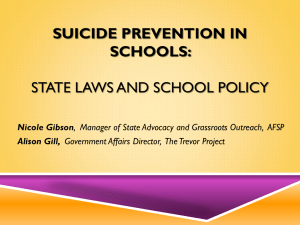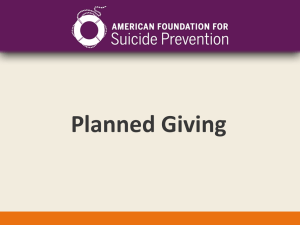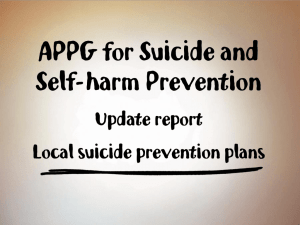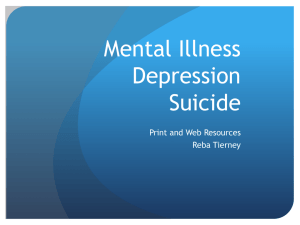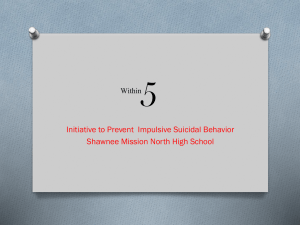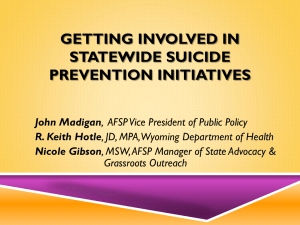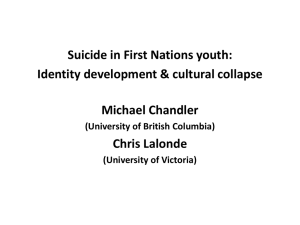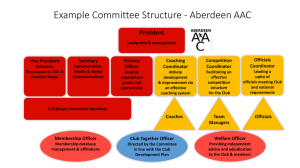Advocacy 101 - American Foundation for Suicide Prevention
advertisement
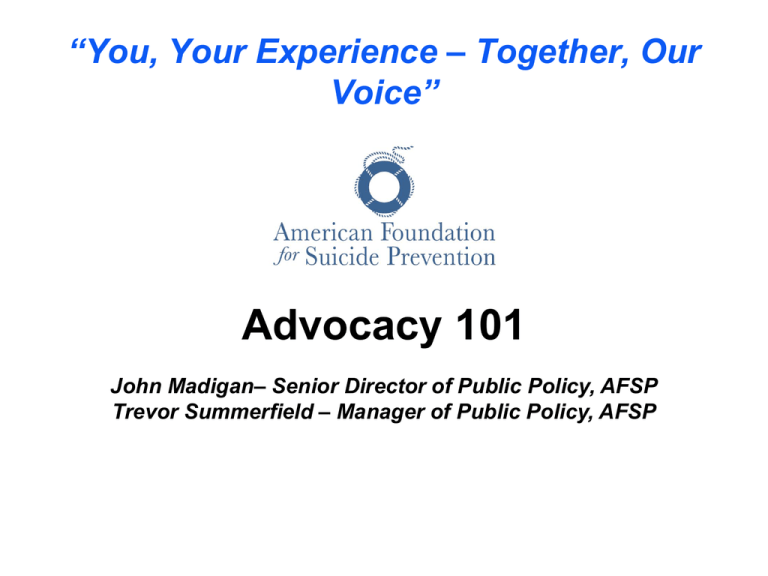
“You, Your Experience – Together, Our Voice” Advocacy 101 John Madigan– Senior Director of Public Policy, AFSP Trevor Summerfield – Manager of Public Policy, AFSP Ad – vo - cate 1) 2) 3) One that pleads the cause of another One that defends or maintains a cause or proposal One that promotes or supports the interests of another Nuts and Bolts of Being an Advocate Educate yourself Educate the public and other stakeholders Educate public officials and their staff Research the Issues Go to: www.spanusa.org www.sprc.org www.afsp.org Attend a national AFSP, AAS or SPRC conference Become and AFSP field advocate Participate in an AFSP webinar Learn about your state’s suicide prevention plan if one exists Subscribe to newsletters, social networking sites and publications Prepare yourself and know the facts Personalize and localize the issues where possible (AFSP state fact sheets provide useful local information) Download and use fact sheets and issue briefs prepared by the AFSP public policy staff At the federal level consult websites for AFSP public policy priorities Examples: • Reauthorization of SAMHSA and adequate funding of Garrett Lee Smith Memorial Act programs • Legislation on veteran and military suicide prevention • Adequate funding of NIMH, NIAAA, NIDA 2011 Federal Policy Priorities On December 1, 2010, the AFSP Board of Directors approved the recommendations from the AFSP Public Policy Council regarding legislative and regulatory priorities to be pursued at the federal and state level in calendar year 2011. AFSP/SPAN USA Public Policy staff will work with AFSP/SPAN USA national volunteers, along with Chapter Field Advocates and AFSP Field staff to attain the following goals and objectives. The federal-level public policy priorities for calendar year 2011 are: • • • • • • • • • • Achieve appropriations at the highest attainable level for Garrett Lee Smith Memorial Act (GLSMA) programs. Maintain veteran and military personnel suicide prevention and education programs as a top priority for Congress, the Administration, DOD and the Department of Veterans Affairs. Encourage the National Institutes of Health (NIH) to invest more substantially in research related to suicide prevention and work with Congress to appropriate more dollars in this area. Fund the National Violent Death Reporting System (NVDRS) with enough money to cover the program in all fifty states. Monitor and respond as necessary to the implementation/potential scale back of health care reform laws as they relate to mental health parity and any other issues related to mental or behavioral health. Achieve reauthorization of the Substance Abuse and Mental Health Services Administration (SAMHSA). Achieve authorization and funding of Native American youth suicide prevention and education programs at the highest levels possible. Achieve authorization and funding of LGBT data collection, support for safe schools and antibullying efforts. Achieve authorization and funding of bridge barrier projects like the Golden Gate Bridge. Achieve authorization and or funding of bullying and cyber-bullying programs and projects. 2011 State Policy Priorities The state-level public policy priorities and activities for calendar year 2011 for AFSP Chapter volunteers and staff, in consultation with national AFSP Public Policy staff are: • • Review and establish a base line understanding of what current exists in each state relative to: – Statewide suicide prevention plan or initiative. How and why this plan operates in the state. What improvements/updates/laws need to be made if any? – What state or local requirements are there for training of school personnel on suicide prevention and education? What needs to be done to improve, update or legislate in this area? – What are the current state laws or regulations on bullying, including cyber-bullying and electronic harassment? What still needs to be done in this area? In addition, each Chapter/state will be asked to evaluate the opportunity for a “Visit to the State Capital Day” as a means to educate the governor and state lawmakers on suicide education and prevention. Each Chapter/state will be asked to review and verify that AFSP Public Policy office has the latest and most accurate information. Each Chapter/state will assess what fits their situation best. In this case, one size may not fit all. For example, in some states a free-standing separate suicide prevention office may work, in others, a hybrid agency/organization might work best. Each Chapter/state will be encouraged to complete this analysis and action plan in the months of November, December and January, to facilitate activity and programs that will allow for timely implementation of laws and or programs to facilitate suicide prevention and education in a particular state. At the federal level, access websites like – www.senate.gov www.house.gov www.whitehouse.gov www.dhha.gov www.samhsa.gov www.nimh.nih.gov Key Phone Numbers to Know White 202-456-1414 US House Switchboard Capitol Senate • 202-224-3121 House • 202-225-3121 Google your state government and legislature web sites, e.g. www.alabama.gov and www.legislature.state.al.us www.illinois.gov and www.ilga.gov www.wv.gov and www.legis.state.wv.us Federal and State Legislative Process – Similarities and differences? At the state level, beyond legislative issues Plan a Suicide Awareness Event in your State Capitol Ask the Governor to declare a statewide Suicide Prevention Week Form a state commission for suicide prevention Federal and State Advocacy Recap Research your issue – organize your thoughts! armed with the facts – Localize and personalize Be Federal, state and local suicide prevention, education and research resources Reach out to Survivors Support groups at local hospitals, hospices, places of worship, community centers and schools Try to get Survivors interested in the AFSP Field Advocate program Reach out to local media - Establish relationships with local reporters Write a letter to the Editor or an Op-Ed piece for your local paper Provide dates and times for survivor meetings and education classes to media Review AFSP media guidelines Speak at a city/town Council or School Board meeting, benefits include Opportunity to speak to a large number of public officials at once Reach like-minded members of your community Make contact with local reporters covering the meeting Reaching out Locally - Recap Reach out to Survivors Local suicide prevention and education collaborators Local Media Other local opportunities to reach out Reaching out to Public Officials You can Write, phone or email Members of Congress or other officials Make an appointment to meet your public officials Work on and distribute nonpartisan analyses and studies Provide technical assistance and advice to legislative bodies Provide testimony Write letters to the editor, appear on television or radio Encourage family, neighbors and friends to be involved Reaching out to Public Officials You can not – Use your non-profit/corporate affiliation to endorse or oppose candidates Use your non-profit/corporate affiliation for any electioneering When speaking or visiting with a Public Official Be brief – brevity is appreciated Explain your personal or professional interest in suicide prevention issues Know how the issue affects suicide prevention, education or research Know precisely what you want the public official to do Offer to be a resource on suicide prevention issues Leave behind short issue briefs or other information Be cordial If you have time, follow up with a thank you note When writing or emailing a public official Fully state your case, using the same facts you would in a visit Make clear you expect a prompt response Be polite and courteous, never threaten or challenge If possible, follow up with a phone call, and say so in your letter or email Reaching Out to Public Officials - Recap Communicating with your elected officials and their staff – Be brief and to the point! or emailing an elected official – Make your case clearly! Writing with your elected official – Remember their staff is important! Visiting Stay in Touch! Become a Resource to your Elected Officials! Making a Difference! Thank You! John Madigan, Senior Director of Public Policy Trevor Summerfield, Manager of Public Policy American Foundation for Suicide Prevention 1010 Vermont Avenue, NW, Suite 408 Washington, DC 20005 jmadigan@afsp.org tsummerfield@afsp.org 202-449-3600 phone 202-449-3601 fax

